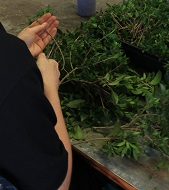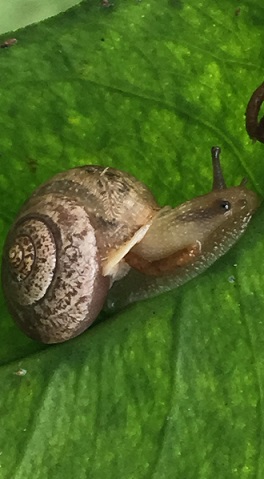Sneak Peek
This is a Self Paced 20-hour course to help you to Understand Plant Pests and Diseases
It always seems that the more work you do in a garden, the more pest and disease problems seem to appear. For this reason, the keen home gardener and the professional landscaper need to be aware about what pests and diseases they may come in contact with, and how to control them.
The Plant Pest and Disease Short Course will help in the identification of these problems. Without correct identification, it would be very difficult to suggest a suitable method of control. For example, a hole in a leaf may indicate damage by a pathogen such as a fungus, bacterium, or virus, or it could be caused by an insect. If you thought the problem was caused by an insect and sprayed it with an insecticide, but it was actually caused by a virus, then the spray is totally wasted.
This short course will help the home gardener and those working in horticulture at an entry level to identify and control a range of the most common pests and diseases of plants.
We live in an age of heightened environmental awareness where there is an emphasis on caring for our environment through sustainable land management, farming, and horticultural practices which includes reducing the use of chemicals. It is therefore important that plant problems are correctly identified so that an appropriate treatment can be chosen. This will help to prevent useless spraying of possibly harmful chemicals or, perhaps more importantly, the spraying of beneficial insects.
A course for:
- Amateur gardeners or Professionals
- Home Gardening, Public Gardening, Commercial Gardening
- Groundsmen, Nurserymen, Farmers, Arborists, Greenkeepers, etc
- Anyone who wants to identify and better manage pests and diseases on plants

Our 20 hour courses are self paced and will help you understand a topic in a short amount of time.
COURSE CONTENT- What do you learn?
Lesson 1: Identifying problems
- Understanding what can go wrong with your plants
- More than one problem
- Finding out what the problem is
- Conducting an inspection
- Alternative approach
- Still unsure?
- Tell-tale symptoms
- The main types of problems
- Pests
- Diseases
- Shortcuts to problem identification
- What insect is it?
- Diagnosis of plant disorders
- Difficult to diagnose problems
Lesson 2: Treating problems
- Different ways to control pests and diseases
- Cultural control
- Biological control
- Physical controls
- Chemical
- Legal control
Lesson 3: Problems and the plants they affect
- Flowers and bulbs
- Fruit and vegetables
- Indoor, shade & greenhouse plants
- Shrubs & climbers
- Trees
- Lawns
- Australian natives
Lesson 4: Pests
- Review of all the major types of pests
- Common garden pests
- Millipedes
- Wasps
Lesson 5: Diseases
- Disease considerations
- Types of pathogens
- Symptoms
- Understanding diseases
- Stages in the development of a disease
- Review of most Common diseases
Lesson 6: Environmental problems
- Common environmental problems
- Foliage burn
- Pollution
- Lack of water
- Drainage problems
- Frost
- Hail
- Shade
- Temperature
- Wind
- Plant tolerance levels
- Ways to protect plants
- Protective structures
- Staking
- Tree guards
- Wind breaks
- Mulching
- Environmental problems in lawns
- Appendices
- Spray programs
- Stages of growth
Learn to Examine Plants, then Identify and Respond to Sickness in Plants
 Plants can get sick; just like animals and people. Sometimes the illness cannot be treated; but if you see what is happening and respond the right way, and fast enough; often you can overcome the problem and bring the plant back to full health.
Plants can get sick; just like animals and people. Sometimes the illness cannot be treated; but if you see what is happening and respond the right way, and fast enough; often you can overcome the problem and bring the plant back to full health.
Problems may be a pest or disease; but it could also be something else perhaps influencing the environmental conditions. This course will raise your awareness of all these possibilities.
Plant disease is generally distinguished from insect and other pest problems. Plant pests actually eat the plant, or break the plant by standing on it (as does the human pest). Plant disease is different. Plant disease is far more subtle, disturbing the microscopic physiological processes which go on within the plant.
When a plant is diseased, it may be affected by one, two, or more different problems. It is often difficult to identify what is wrong with a plant because the problem is commonly a combination of problems.
Example
A plant is weakened by poor nutrition in the soil. Excessively wet conditions create an environment conductive to the growth of infectious fungi. The plant weakened by poor nutrition is infected by the fungal disease which develops in wet conditions. The roots begin to rot through fungal attack and because the roots are damaged, the plant does not take in water and nutrients as well as it would normally. The leaves of the plant are infected by a second disease because of the situation above which has made the plant weak and more susceptible to infection.
Plant pests for example, insects, snails, etc. are classified and named in much the same way as weeds; in that there are both common and scientific names. Terms such as grub or bug might commonly be used to refer to a very wide range of pests. Strictly speaking scientists use such terms in a far more specific way. A scientist uses the term bug to refer to a very specific group of insect species; for example.
Common names are used more commonly with pests and diseases than with weeds but they must be used accurately and in accordance with their specific application if they are to be of any real value.
Plant pests can include a wide range of things, including:
- Insects that feed on plants or that transmit other problems i.e. fungal and virus diseases from plant to plant.
- Animals which cause physical damage by digging around plants, knocking plants or eating plants (e.g. goats, birds, dogs, etc.).
- Animals causing burn to plant tissue by urinating on them (e.g. dogs).
- People causing physical harm to plants by compacting soil through over use, knocking and damaging plant tissue, transmitting diseases to the vicinity of "clean" plants, by deliberate vandalism, and through other forms of mismanagement.
- Snails, slugs, nematodes, wood lice, mites and other small animals feeding on plants and also transmitting diseases, etc.
Support from Expert Tutors
You have access to expert tutors through our student help desk all the time you are studying this course. Our school maintains help desks in both of our offices -in Australia and the UK; and has staff on duty five days a week manning phones, online chat and emails. Any questions that you have about what you are studying will be dealt with promptly (usually the same working day, often immediately).
- If there is something you read or research that you don't understand, ask for help.
- If you want to learn more about something in the course, have a conversation and get advice from a tutors.
- If you need direction to find more information, ask.
- If you need advice on moving forward with your work, career or studies after the course, ask. (Free career and business advice).
How does this course work?
You can enrol at any time
Once you have paid for the course, you will be able to start straight away.
Study when and where you like. Work through at your own pace.
You can download your study-guide to your smart phone, tablet or laptop to read offline.
There are automated self-assessment tests you can complete at the end of each lesson. You can attempt these as many times as you wish and each time, upon completion, you can see your results. You will need internet access to complete the self assessment tests.
At the end of the course, you are presented with a large assessment which can be attempted online, anywhere, anytime. If you achieve a 60% pass in the exam; you immediately receive a downloadable certificate of completion with your name on it. If you do not achieve a 60% pass rate, you can contact us to re-sit your exam. ( email- admin@acs.edu.au )
Contact us at anytime if you have any issues with the course. admin@acs.edu.au